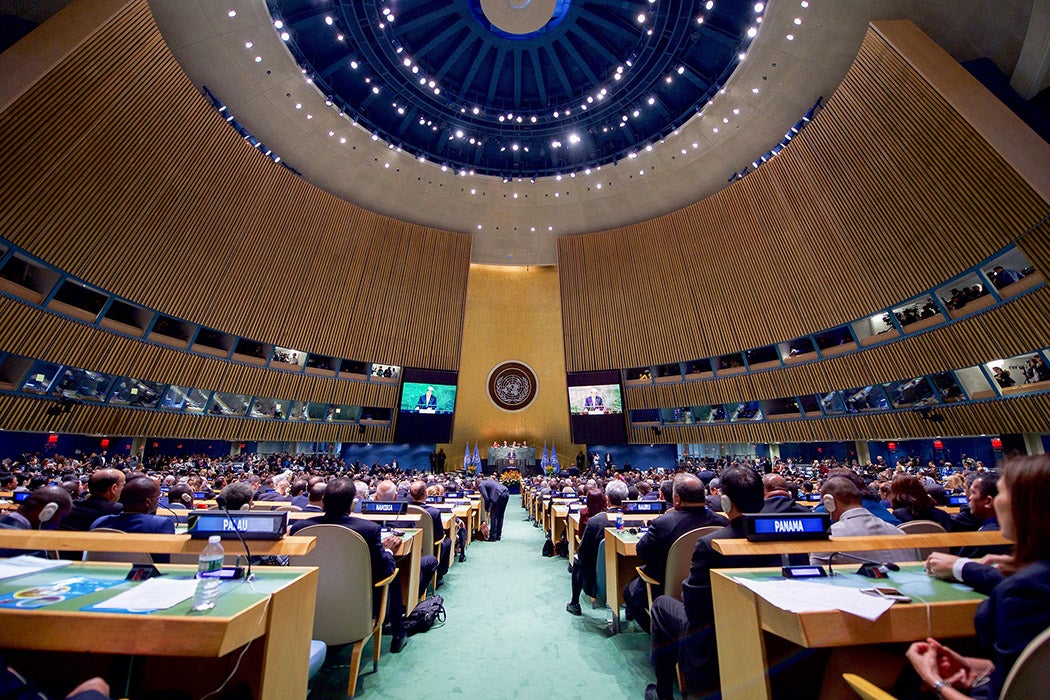
Adopted by almost 200 parties at the 2015 UN Climate Change Conference, the Paris Agreement captures international ambitions for cooperative climate action.

U.S. Secretary of State John Kerry addresses delegates before he signed the COP21 Climate Change Agreement on Earth Day, April 22, 2016
April 22, 2023 April 21, 2023 The icon indicates free access to the linked research on JSTOR.The Paris Agreement on Climate was adopted in December 2015 at the twenty-first meeting of the Committee of the Parties (COP21), as part of a continuing international effort to mitigate climate change headed by the United Nations. The agreement was a successor to the Kyoto Protocol of 1997, which set specific targets, financial contributions, and monitoring and enforcement mechanisms to meet them. The Kyoto Protocol was seen by some large developed countries as harmful to their economies, and it raised complaints that other parties weren’t required to make sufficient reductions in emissions. The United States never ratified the treaty, and Canada announced its withdrawal in 2011.


In contrast, the Paris Agreement has been criticized for its lack of both country-specific goals for emission reduction and enforcement mechanisms. Instead it seeks to limit global temperature increase to below 2℃, and achieve zero greenhouse gas emissions at some point between the years 2030 and 2050.
In consideration of Earth Day, below is an annotation of the Introduction of the Agreement, with relevant scholarship covering the populations, economies, and governments affected by climate change. As always, the supporting research is free to read and download. If you see a small red letter J after a hyperlink—that looks like the one below, click it for free access to that content on JSTOR.
The red J indicates free access to JSTOR.
The Parties to this Agreement,
Being Parties to the United Nations Framework Convention on Climate Change, hereinafter referred to as “the Convention,”
Pursuant to the Durban Platform for Enhanced Action established by decision 1/CP.17 of the Conference of the Parties to the Convention at its seventeenth session,
Also recognizing the specific needs and special circumstances of developing country Parties, especially those that are particularly vulnerable to the adverse effects of climate change, as provided for in the Convention,
Taking full account of the specific needs and special situations of the least developed countries with regard to funding and transfer of technology,
Acknowledging that climate change is a common concern of humankind, Parties should, when taking action to address climate change, respect, promote and consider their respective obligations on human rights, the right to health, the rights of indigenous peoples, local communities, migrants, children, persons with disabilities and people in vulnerable situations and the right to development, as well as gender equality, empowerment of women and intergenerational equity,
Recognizing the importance of the conservation and enhancement, as appropriate, of sinks and reservoirs of the greenhouse gases referred to in the Convention,
Noting the importance of ensuring the integrity of all ecosystems, including oceans, and the protection of biodiversity, recognized by some cultures as Mother Earth, and noting the importance for some of the concept of “climate justice” when taking action to address climate change,
Recognizing the importance of the engagements of all levels of government and various actors, in accordance with respective national legislations of Parties, in addressing climate change,
Have agreed as follows: